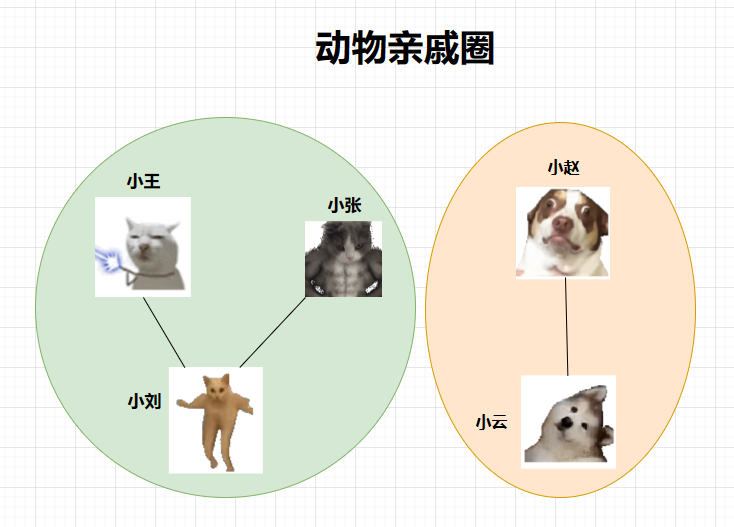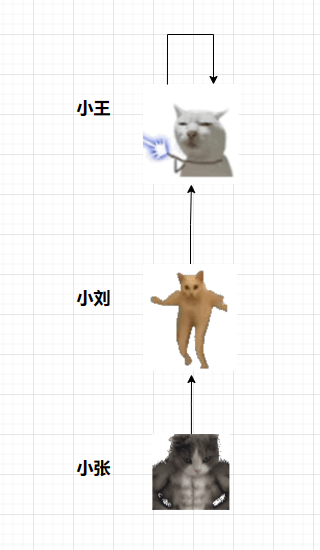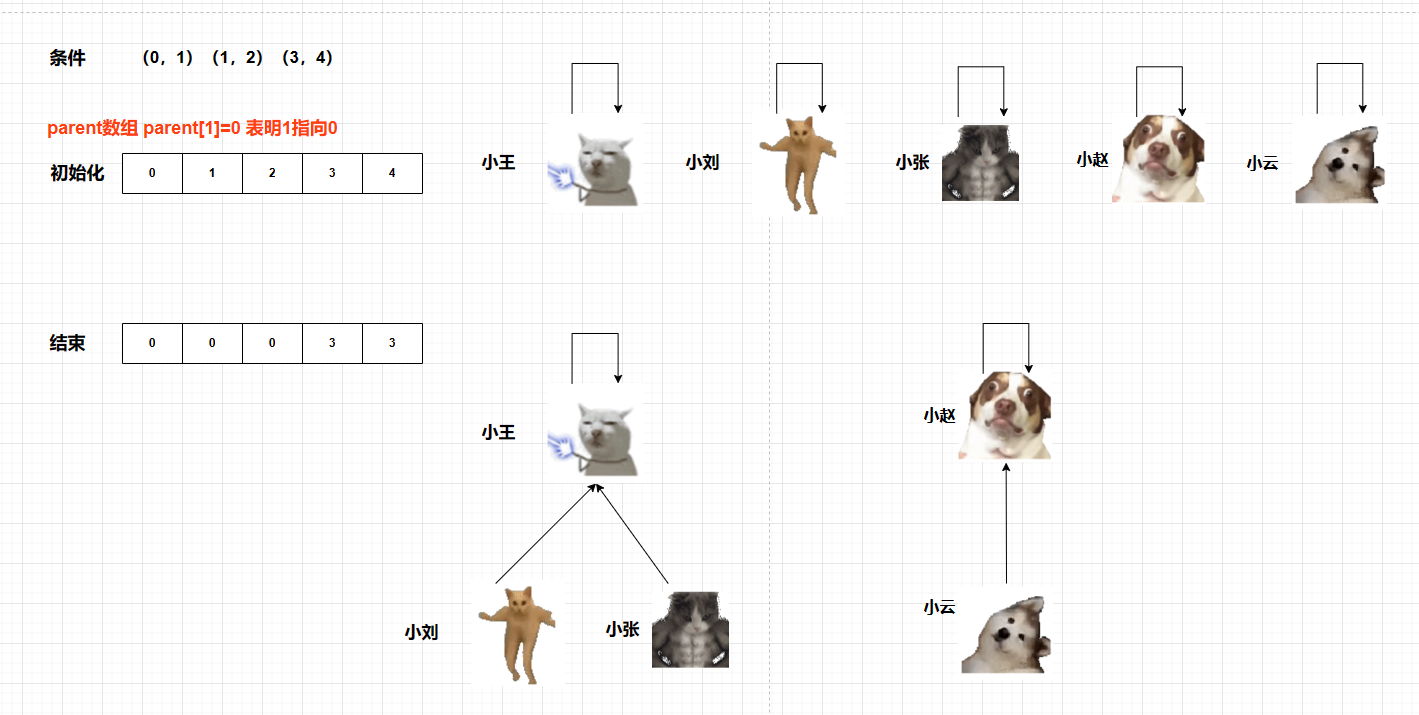查并集
1.引入
查并集:查并集是什么?上来先不讲概念,先用例子引入,老师好像是这样讲课的。
猫猫集合:小王和小刘是亲戚,小张和小刘是亲戚
狗子集合:小赵和小云是亲戚
那么小动物的亲戚圈如下,请问小赵和小王是亲戚吗?

将以上语言,转换为程序语言:
输入(A,B)(C,B) (D,E)
请问有几个亲戚圈?
亲戚最大有多少?
A、C是不是亲戚?
当然,圈子这个词也该换换了
输入(A,B)(C,B) (D,E) 无向路径
请问有几个连通分量?
最大连通分量是多少?
A、C是不是可连通的?
查并集
我们怎么知道小王、小张、小刘是一个圈子的人?喔, 把你的心我的心串一串,串一株幸运草串一个同心圆, 让所有期待未来的呼唤。
没错就是串一串,假如果我们这么串:

小刘的Root是小王、小张的Root是小网、小王的Root是小王。他们的Root相同,我们说他们是一个圈子的人,是亲戚。
那么问题来了?怎么构建这个树,哦不,串。

哦哦哦,太神奇了,现在我想问的是,数组怎么转换来的?
那不得不讲三个方法:
// parent数组 parent[1]=0 表明1指向0
int[] parent=new int[];
- MAKE-SET:创建一个新的集合,初始化每个元素都是一个集合,每个元素的parent都是自己。
for(int i=0;i<5;i++){
parent[i]=i;
}
- FIND-SET(x):寻找一个SET的代表元素,也就是根元素
int find(int x){
if(x!=parent[x]){ //你的指针不指向你
x=find(parent[x]);
}
return x;
}
- UNION(x,y):将x,y两个集合合并
void union(int x,int y){
int x=find(x);
int y=find(y);
if(x!=y){
parent[x]=y;
}
}
哦,那程序怎么写?
class Union-Find{
int[] parent;
public Union(int x){
parent=new int[x];
for(int i=0;i<x;i++){
parent[i]=i;
}
}
int find(int x){
if(x!=parent[x]){ //你的指针不指向你
x=find(parent[x]);
}
return x;
}
void union(int x,int y){
int x=find(x);
int y=find(y);
if(x!=y){
parent[x]=y;
}
boolean isConnect(x,y){
return find(x)==find(y);
}
}
public class Main{
public static void main(string[] args){
UnionFind unionFind=new UnionFind(5);
unionFind.union(0,1);
unionFind.union(1,2);
unionFind.union(3,4);
System.out.println(unionFind.isConnect(1,4));
}
}
哦,天下无敌了,那做个题试试。🐔🐔🐔漏出鸡脚。
查并集题目练习
朋友圈(后端开发卷)
现在有 105 个用户,编号为 1- 105,现在已知有 m 对关系,每一对关系给你两个数 x 和 y ,代表编号为 x 的用户和编号为 y 的用户是在一个圈子中,例如: A 和 B 在一个圈子中, B 和 C 在一个圈子中,那么 A , B , C 就在一个圈子中。现在想知道最多的一个圈子内有多少个用户。
输入描述:
第一行输入一个整数T,接下来有T组测试数据。
对于每一组测试数据:第一行输入1个整数n,代表有n对关系。
接下来n行,每一行输入两个数x和y,代表编号为x和编号为y的用户在同一个圈子里。
1 ≤ T ≤ 10
1 ≤ n ≤ 2*106
1 ≤ x, y ≤ 105
输出描述:
对于每组数据,输出一个答案代表一个圈子内的最多人数
示例1
输入例子:
2
4
1 2
3 4
5 6
1 6
4
1 2
3 4
5 6
7 8
输出例子:
4
2
代码:
class UnionNode {
Integer parent;
Integer size;
public UnionNode(Integer parent, Integer size) {
this.parent = parent;
this.size = size;
}
public Integer getParent() {
return parent;
}
public void setParent(Integer parent) {
this.parent = parent;
}
public Integer getSize() {
return size;
}
public void setSize(Integer size) {
this.size = size;
}
}
class UnionFind {
/**
* parent[i]表示i这个元素指向的父亲节点
*/
HashMap<Integer, UnionNode> parent;
int setCount;
public UnionFind() {
parent = new HashMap<>();
}
int getMaxSize() {
int max = 0;
for (Map.Entry<Integer, UnionNode> entry : parent.entrySet()) {
max = max > entry.getValue().getSize() ? max : entry.getValue().getSize();
}
return max;
}
public int find(int x) {
if (!parent.containsKey(x)) {
parent.put(x, new UnionNode(x, 1));
setCount++;
}
return parent.get(x).getParent() == x ? x : find(parent.get(x).getParent());
}
public boolean unit(int x, int y) {
x = find(x);
y = find(y);
if (x == y) {
return false;
}
if (parent.get(x).getSize() < parent.get(y).getSize()) {
int tem = x;
x = y;
y = tem;
}
int xsize = parent.get(x).getSize();
int ysize = parent.get(y).getSize();
parent.put(y, new UnionNode(x, 0));
parent.get(x).setSize(xsize + ysize);
--setCount;
return true;
}
public boolean connected(int x, int y) {
x = find(x);
y = find(y);
return x == y;
}
}
public class DemoApplication {
public static void main(String[] args) {
UnionFind unionFind = new UnionFind();
unionFind.unit(0, 1);
unionFind.unit(1, 2);
unionFind.unit(3, 4);
System.out.println(unionFind.getMaxSize());
}
}
本文来自博客园,作者:帅气的涛啊,转载请注明原文链接:https://www.cnblogs.com/handsometaoa/p/17335043.html




【推荐】国内首个AI IDE,深度理解中文开发场景,立即下载体验Trae
【推荐】编程新体验,更懂你的AI,立即体验豆包MarsCode编程助手
【推荐】抖音旗下AI助手豆包,你的智能百科全书,全免费不限次数
【推荐】轻量又高性能的 SSH 工具 IShell:AI 加持,快人一步
· 无需6万激活码!GitHub神秘组织3小时极速复刻Manus,手把手教你使用OpenManus搭建本
· C#/.NET/.NET Core优秀项目和框架2025年2月简报
· Manus爆火,是硬核还是营销?
· 终于写完轮子一部分:tcp代理 了,记录一下
· 【杭电多校比赛记录】2025“钉耙编程”中国大学生算法设计春季联赛(1)